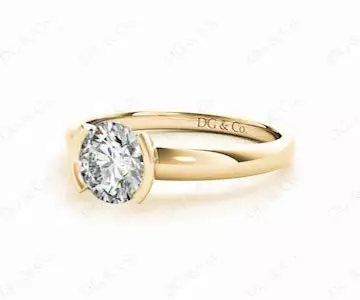Education Settings
PRONG SETTING
The prong setting is the most common type of setting and involves two or more metal claws called prongs. The diamond or gemstone is grasped by projecting metal prongs that form a base. The tips of the prongs are bent so they rest just over the face of the stone, holding it firmly in place. The prong setting is particularly popular with diamond solitaire engagement rings. This type of setting exposes nearly all of the diamond to light, creating a brilliant and lustrous look. This is a secure setting and holds even the most fragile of stones.

SHARE PRONG SETTING
In a variation of the classic prong setting, prongs are wrapped around the crown of a stone to secure it in place. This type of setting minimizes the presence of metal, allowing more light to pass through a diamond or gemstone.
CHANNEL SETTING
Channel setting is a distinctive look created when accent stones are set into a grooved channel and laid edge-to-edge in a row. This design protects the gemstones, making this setting style ideal for daily wear and a good option for an active person.

BEZEL SETTING
A bezel setting is sleek and modern—the metal of the band is used to completely surround the diamond, following exactly the stone’s shape. This is an ideal choice for an active lifestyle.
HALF BEZEL SETTING
Similar to the bezel setting, the half-bezel setting also has a metal rim or collar that encircles the stone. However, in the half-bezel setting the rim only surrounds a portion of the stone, exposing the other sides of the diamond or gemstone. This is a secure setting and allows for more of the stone to be exposed and appreciated. The half-bezel setting works well with solitaire diamonds.

PAVE SETTING
Pavé is a type of bead setting where the gemstone is set into a recessed hole in the mounting and held in place by small beads of metal attached at the stone’s girdle. Many small gems are placed close together, usually in a honeycomb pattern, creating the appearance that the jewelry has been ‘paved’ with diamonds. Pave is an elegant setting. But if the wearer is extremely active, the diamonds can be vulnerable to falling out, and therefore should be handled with care.
V-PRONG SETTING
A v-prong setting is used to protect the ends of diamonds or gemstones that come to a point such as pear shape, princess or marquise cut stones. V prongs grasp the stone at the corners, covering their edges with metal claws and sheilding them from wear and tear. Because the ends of these stones are fragile, it is necessary to protect them from damage and hold the stones securely in place.

TENSION SETTING
A tension setting allows the ring to act as a spring, holding the diamond in place. This setting type is known for its unique appearance, allowing the diamond to appear to be floating. Further, there is no metal underneath the diamond, which means the stone can be cleaned easily. Diamonds are natural grease magnets, so when dirty, they appear duller in appearance.

BAR SETTING
Bar settings are similar to channel settings, but the difference is that channel settings enclose the diamond on all sides whereas the bar setting leaves the diamond exposed on two sides, held in place by the metal bars that secure the stones on the other two sides.
Free Shipping
Lifetime
Guarantee
Complementary
Valuation
Conflict Free
Diamonds

30 Day Money Back
Guarantee
DG & Co. Guarantees
Free Shipping
Lifetime
Guarantee
Complementary
Valuation
Conflict Free
Diamonds

30 Day Money Back
Guarantee
Contact Us





